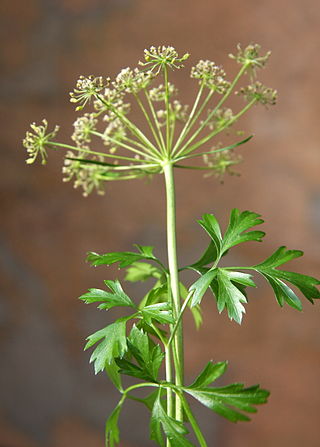
Parsley, or garden parsley is a species of flowering plant in the family Apiaceae that is native to Greece, Morocco and the former Yugoslavia. It has been introduced and naturalized in Europe and elsewhere in the world with suitable climates, and is widely cultivated as an herb and a vegetable.
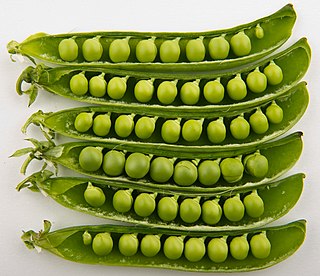
Pea is a pulse, vegetable or fodder crop, but the word often refers to the seed or sometimes the pod of this flowering plant species. Carl Linnaeus gave the species the scientific name Pisum sativum in 1753. Some sources now treat it as Lathyrus oleraceus; however the need and justification for the change is disputed. Each pod contains several seeds (peas), which can have green or yellow cotyledons when mature. Botanically, pea pods are fruit, since they contain seeds and develop from the ovary of a (pea) flower. The name is also used to describe other edible seeds from the Fabaceae such as the pigeon pea, the cowpea, the seeds from several species of Lathyrus and is used as a compound form for example Sturt's desert pea.
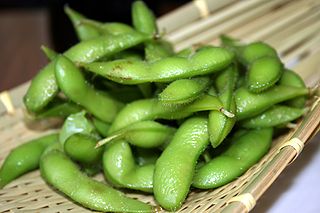
Edamame is an East Asian dish prepared with immature soybeans in the pod. The pods are boiled or steamed and may be served with salt or other condiments. The dish has become popular across the world because it is rich in vitamins, dietary fiber, and isoflavones. When the beans are outside the pod, the term mukimame is also sometimes used in Japanese. Edamame are a common side dish in Japanese cuisine and as an appetizer to alcoholic beverages such as beer or shōchū. As an ingredient Edamame are found in both sweet and savory dishes such as takikomi gohan, tempura, and zunda-mochi.

Sweet corn, also called sweetcorn, sugar corn and pole corn, is a variety of corn grown for human consumption with a high sugar content. Sweet corn is the result of a naturally occurring recessive mutation in the genes which control conversion of sugar to starch inside the endosperm of the corn kernel. Sweet corn is picked when still immature and prepared and eaten as a vegetable, rather than field corn, which is harvested when the kernels are dry and mature. Since the process of maturation involves converting sugar to starch, sweet corn stores poorly and must be eaten fresh, canned, or frozen, before the kernels become tough and starchy.

Spaghetti squash or vegetable spaghetti is a group of cultivars of Cucurbita pepo subsp. pepo. They are available in a variety of shapes, sizes, and colours, including ivory, yellow and orange, with orange having the highest amount of carotene. Its center contains many large seeds. When raw, the flesh is solid and similar to other raw squash. When cooked, the meat of the fruit falls away from the flesh in ribbons or strands that look like and can be used as an alternative to spaghetti.

Cress, sometimes referred to as garden cress to distinguish it from similar plants also referred to as cress, is a rather fast-growing, edible herb.

A lima bean, also commonly known as butter bean, sieva bean, double bean or Madagascar bean, is a legume grown for its edible seeds or beans.

Phaseolus vulgaris, the common bean, is a herbaceous annual plant grown worldwide for its edible dry seeds or green, unripe pods. Its leaf is also occasionally used as a vegetable and the straw as fodder. Its botanical classification, along with other Phaseolus species, is as a member of the legume family, Fabaceae. Like most members of this family, common beans acquire the nitrogen they require through an association with rhizobia, which are nitrogen-fixing bacteria.

The winged bean, also known as cigarillas, goa bean, four-angled bean, four-cornered bean, manila bean, princess bean, star bean, kamrangi bean, pea, dragon bean, is a tropical herbaceous legume plant.

The asparagus bean is a legume cultivated for its edible green pods containing immature seeds, like the green bean. It is also known as: yardlong bean, pea bean, long-podded cowpea, Chinese long bean, snake bean, bodi, and bora. Despite the common name of "yardlong", the pods are actually only about half a yard long, so the subspecies name sesquipedalis is a more accurate approximation.

The snap pea, also known as the sugar snap pea, is an edible-pod pea with rounded pods and thick pod walls, in contrast to snow pea pods, which are flat with thin walls. The name mangetout can apply to snap peas and snow peas.

Green beans are young, unripe fruits of various cultivars of the common bean, although immature or young pods of the runner bean, yardlong bean, and hyacinth bean are used in a similar way. Green beans are known by many common names, including French beans, string beans, and snap beans or simply "snaps." In the Philippines, they are also known as "Baguio beans" or "habichuelas" to distinguish them from yardlong beans.

The black turtle bean is a small, shiny variety of the common bean especially popular in Latin American cuisine, though it can also be found in the Cajun and Creole cuisines of south Louisiana. Like all varieties of the common bean, it is native to the Americas, but has been introduced around the world. It is also used in Indian cuisine, Tamil cuisine, where it is known as karuppu kaaramani and in Maharashtrian cuisine, where it is known as Kala Ghevada. It is widely used in Uttrakhand India also known as "Bhatt". It is a rich source of iron and protein. The black turtle bean is often simply called the black bean, although this terminology can cause confusion with at least three other types of black beans.
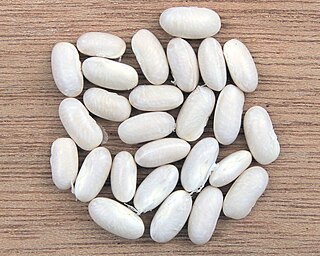
The navy bean, haricot bean, pearl haricot bean, Boston bean, white pea bean, or pea bean is a variety of the common bean native to the Americas, where it was first domesticated. It is a dry white bean that is smaller than many other types of white beans, and has an oval, slightly flattened shape. It features in such dishes as baked beans, various soups such as Senate bean soup, and bean pies.
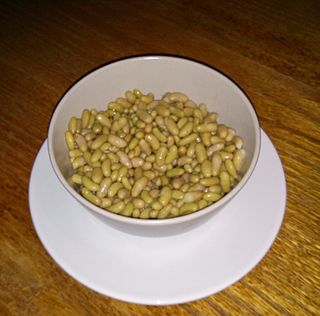
The flageolet bean is a variety of the common bean originating from France. The flageolet is picked before full maturity and dried in the shade to retain its green color. The bean is small, light green, and kidney-shaped. The texture is firm and creamy when shelled and cooked. The flageolet bean is grown in California.

The snow pea is an edible-pod pea with flat pods and thin pod walls. It is eaten whole, with both the seeds and the pod, while still unripened.
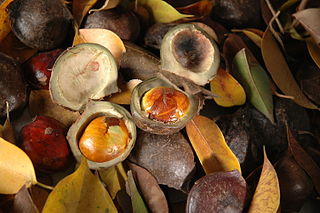
Archidendron pauciflorum, commonly known as djenkol, jengkol or jering, is a species of flowering tree in the pea family, Fabaceae. It is native to Southeast Asia, where the seeds are also a popular dish. They are mainly consumed in Indonesia, Thailand, Myanmar, and Vietnam, prepared by frying, boiling, or roasting, and eaten raw. The beans are mildly toxic due to the presence of djenkolic acid, an amino acid that causes djenkolism. The beans and leaves of the djenkol tree are traditionally used for medicinal purposes, such as purifying the blood. To date, djenkol is traded on local markets only.

The cranberry bean is a variety of common bean first bred in Colombia as the cargamanto. It is also known as the Borlotti bean, Roman bean, romano bean, saluggia bean, gadhra bean orrosecoco bean. The bean is a medium to large tan or hazelnut-colored bean splashed or streaked with red, magenta or black.
The Appaloosa bean is a cultivar bean variety of the species Phaseolus vulgaris.

The Calypso bean, pickle bean, orca bean, or yin yang bean, is a bean cultivar of the species Phaseolus vulgaris.



















